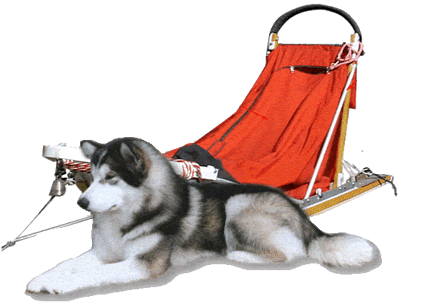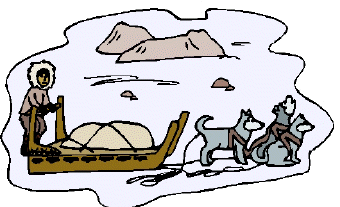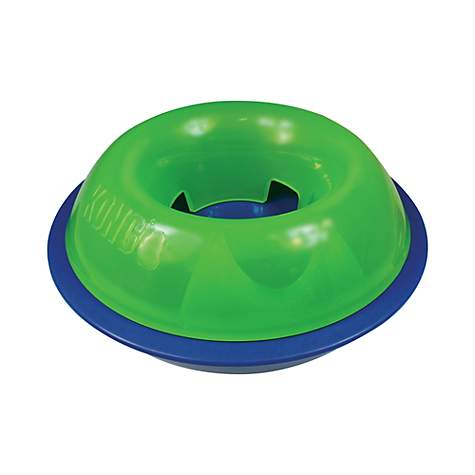Alaskan Malamutes...
A Very Short History
Alaskan Malamutes have been trained for many tasks, as well as Malamutes and companions. However, their heritage, intelligence and athletic ability, as well as keen senses are suited to some areas better than others. He is a very trainable dog, he is somewhat limited by what was appropriate for him as a sled dog, and the sense and ambition of his owner. If you wish to pursue formal titles or not, your Malamute will be trained. Either actively or passably by doing nothing, allowing him to do as he pleases.
 All domestic dogs were selectively bred for a
specific purpose. Usually they will retain some puppy-like trait useful
to man. The Malamute is a "natural" breed, its evolution brought
about by a need for survival - similar to the wolf or dingo - yet, unlike them,
he has formed a strong alliance with man. This is domestication.
What is the purpose of a Malamute? They were not bred to heard livestock, retrieve
dead birds (in a still edible condition), to stay home and guard. His
purpose was to cooperate with man for their mutual survival. Malamutes
are a primitive, early form of dog, about as close to the original wild types
as any domestic breed. Until 80 years ago, it was common for Malamutes
to run loose and become semi-feral in summer. In winter they were part
of the family, drafting loads, playing with children, adding the warmth of their
body heat to the oil lamp warming the shelter. Historically, they were
used to chase and attack polar bears and helped hunt seal or walrus for their
semi-nomadic owners who lived communally with no need of guarding behaviors
against other people. The only thing the Malamute needed to guard was
his dinner from other Malamutes and wild animals. Visitors were usually
from hundreds of miles away, a welcome sight possibly bringing food as a trading
commodity or for tribal celebrations (definitely someone to be welcomed!)
All domestic dogs were selectively bred for a
specific purpose. Usually they will retain some puppy-like trait useful
to man. The Malamute is a "natural" breed, its evolution brought
about by a need for survival - similar to the wolf or dingo - yet, unlike them,
he has formed a strong alliance with man. This is domestication.
What is the purpose of a Malamute? They were not bred to heard livestock, retrieve
dead birds (in a still edible condition), to stay home and guard. His
purpose was to cooperate with man for their mutual survival. Malamutes
are a primitive, early form of dog, about as close to the original wild types
as any domestic breed. Until 80 years ago, it was common for Malamutes
to run loose and become semi-feral in summer. In winter they were part
of the family, drafting loads, playing with children, adding the warmth of their
body heat to the oil lamp warming the shelter. Historically, they were
used to chase and attack polar bears and helped hunt seal or walrus for their
semi-nomadic owners who lived communally with no need of guarding behaviors
against other people. The only thing the Malamute needed to guard was
his dinner from other Malamutes and wild animals. Visitors were usually
from hundreds of miles away, a welcome sight possibly bringing food as a trading
commodity or for tribal celebrations (definitely someone to be welcomed!)

Sled dogs did more than pull sleds! Their claim to fame is survival in the harshest environment on earth. But most people never think beyond their beauty and sledding ability. He is not a "dumb" breed for working so hard. A Malamute expresses his vitality and joy of life by doing everything with gusto!
In a semi-nomadic society, there are no property lines, so a Malamute will not be reliable to stay on your unfenced property. He's not suitable for guard dog training because to make him willing to attack humans his entire trust of all humans must be undermined. He will never be trustworthy with livestock. His behavior reflects what had survival value for him as an arctic dog. He will form strong dominance hierarchies with other dogs and members of the family. He will be a precocious pup and will need training earlier. Training needs to be loving, but much firmer, with no lapses in permissiveness. You must be fair, loving, understanding and NEVER let him get away with anything. You can't put off training until a more convenient time!

The best test of owning a Malamute is CONVINCING him you are worth listening to. You will need to earn your alpha status through consistency, fairness and respect. An important concept usually missing from dog training manuals is WHY your dog would want your praise. It's the pack drive, the need for structure and hierarchy. Malamutes have a strong pack drive and will crave the approval of their acknowledged superiors, but are not moved or impressed by either the praise or complaints of an equal or subordinate. A Malamute must understand WHY he should obey. Survival in the arctic does not promote blind, steadfast obedience a la Golden Retriever. What motivates a Malamute? His own rule book on life's priorities: allegiance to and love of a worthy owner, food/water/comfort and survival.
Interesting article about the Arctic - This forum thread is quite long, but so worth it! Gorgeous pictures and information about how hard life is in the arctic where the Malamute is from...

















